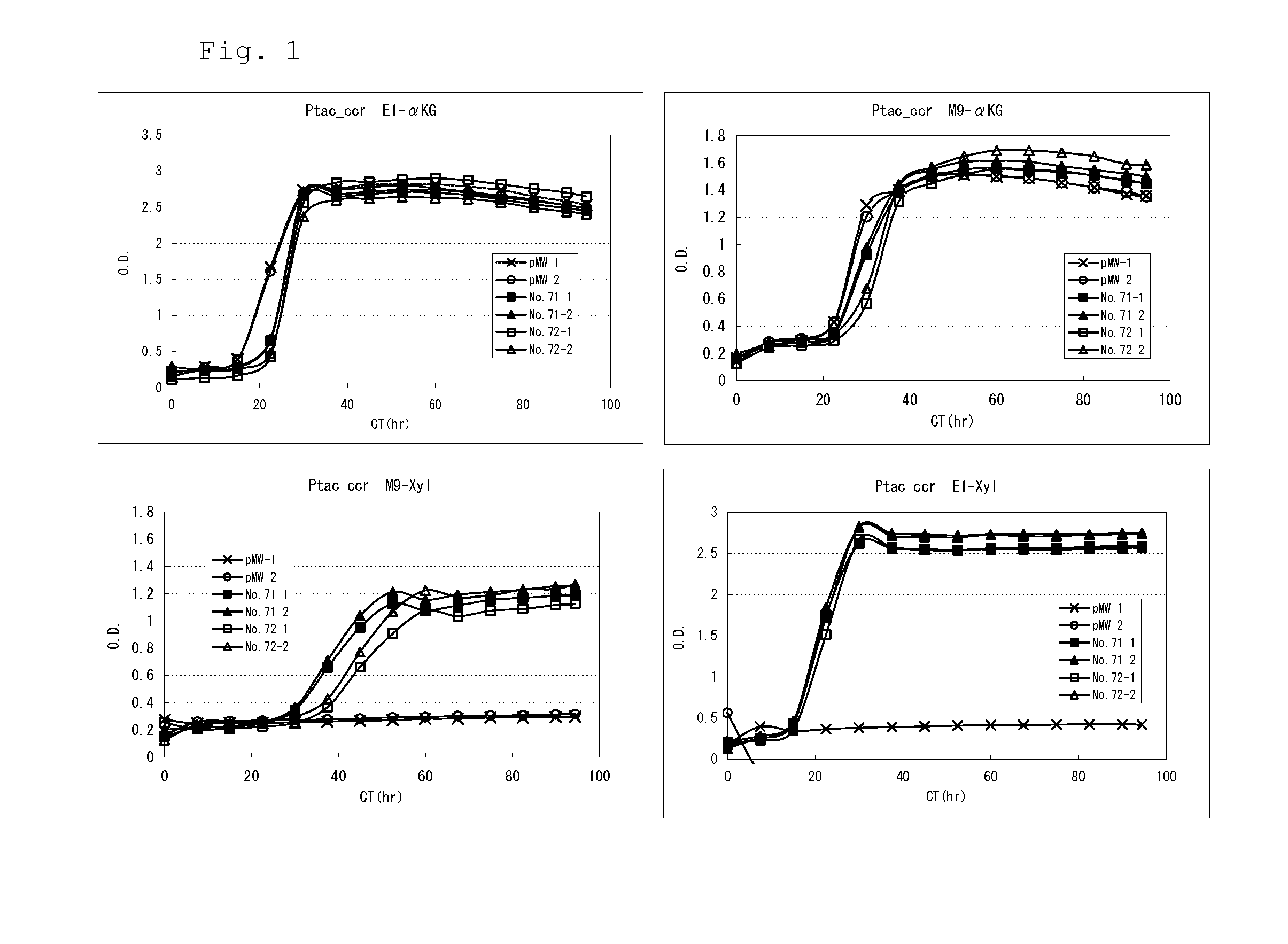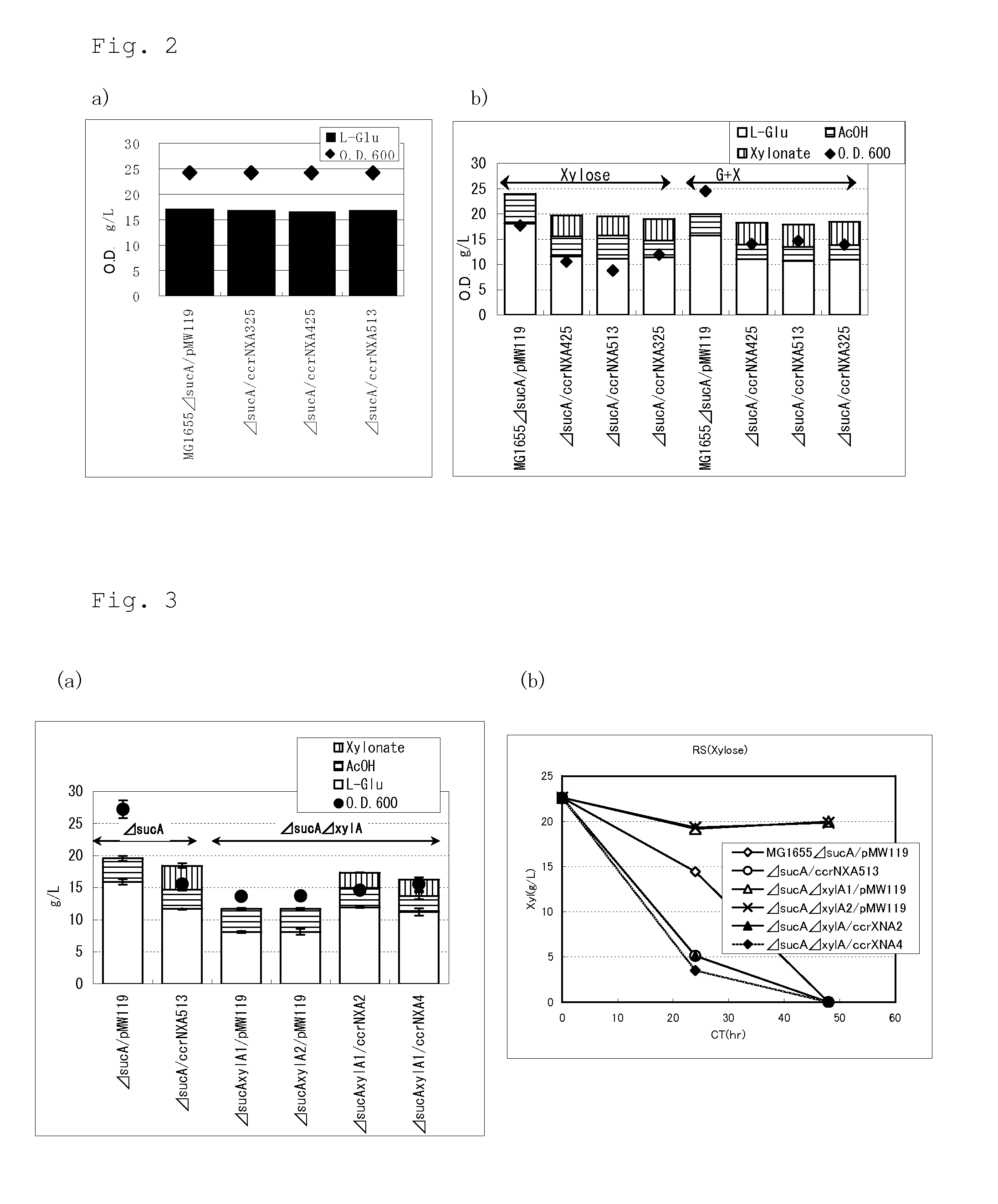Method for Producing a Target Substance by Fermentation
a technology of target substances and fermentation, applied in the direction of lyases, enzymology, carbon-oxygen lyases, etc., can solve the problem of relative cos
- Summary
- Abstract
- Description
- Claims
- Application Information
AI Technical Summary
Benefits of technology
Problems solved by technology
Method used
Image
Examples
example 1
Introduction of NXA Pathway into Pantoea ananatis
[0271]Construction of plasmid pTWV228Ptac_ccrNXA for introduction of NXA Pathway
[0272]The NXA pathway has been reported in C. crescentus (Stephens, C. et al., J. Bacteriol., 189(5):181-2185, 2007). To obtain the genes coding for the enzymes of the NXA pathway of C. crescentu, the following methods were employed.
[0273]The genome of C. crescentus has a length of about 4 Mb, in which five genes form an operon structure (Journal of Bacteriology, 189:2181-2185, 2007). The genome was extracted from the published strain of C. crescentus (CB-15 (ATCC 19089, available from ATCC), and the genes were cloned and an expression vector for the genes constructed.
[0274]The expression vectors were constructed by using Clontech In-Fusion Cloning Kit.
[0275]The following four kinds of DNA fragments were amplified by PCR using chromosomal DNA of C. crescentus CB-15 (ATCC 19089) for the following i), ii) and iii), and pMW119 for the following iv) as the te...
example 2
Introduction of NXA Pathway into Escherichia coli
[0302]Expression of NXA Pathway in E. Coli
[0303]By using a strain deficient in isocitrate dehydrogenase (Δicd), which is an enzyme of the TCA cycle and produces αKG from isocitric acid, expression of the NXA pathway was attempted by growth complementation in a minimal medium containing xylose as the sole carbon source. Since the icd gene-deficient strain cannot produce αKG, it cannot grow in a minimal medium containing xylose as the sole carbon source. However, if the ability to produce αKG from xylose can be imparted by introducing the NXA pathway, then this strain acquires the ability to grow in such a medium.
[0304]Specifically, the JW1122 strain, which is an icd gene-deficient strain of Keio Collection (cgsc.biology.yale.edu / Person.php?ID99553, available from E. coli Genetic Resource Center at Yale CGSC, The Coli Genetic Stock Center), was used as a host bacterial strain, and by introducing and expressing the NXA pathway in that ...
example 3
Introduction of NXA Pathway into Corynebacterium glutamicum
[0338]Construction of Plasmid pVK9Peftu_ccrNXA for Introduction of NXA Pathway
[0339]A plasmid having a sequence containing the promoter sequence of the elongation factor Tu (EF-Tu) gene, tuf (WO2008 / 114721, SEQ ID NO: 33, henceforth referred to as “Peftu”) and xylD ligated downstream from the promoter sequence was constructed by using Clontech In-Fusion Cloning HD Kit (Clontech). First, PCR was performed by using the chromosomal DNA of the C. glutamicum ATCC 13869 strain as the template, as well as primers Peftu(Pst) (SEQ ID NO: 58) and Peftu_Rv (SEQ ID NO: 59) to obtain a fragment containing the Peftu sequence. This PCR was performed by using PrimeSTAR HS Polymerase according to the protocol attached to this enzyme.
[0340]Furthermore, PCR was performed by using pTWV228Ptac_ccrNXA as the template, as well as primers Peftu_xylXABCD_fw (SEQ ID NO: 60) and Peftu_xylXABCD_ry (SEQ ID NO: 61) to obtain a fragment containing the xy...
PUM
 Login to View More
Login to View More Abstract
Description
Claims
Application Information
 Login to View More
Login to View More - R&D
- Intellectual Property
- Life Sciences
- Materials
- Tech Scout
- Unparalleled Data Quality
- Higher Quality Content
- 60% Fewer Hallucinations
Browse by: Latest US Patents, China's latest patents, Technical Efficacy Thesaurus, Application Domain, Technology Topic, Popular Technical Reports.
© 2025 PatSnap. All rights reserved.Legal|Privacy policy|Modern Slavery Act Transparency Statement|Sitemap|About US| Contact US: help@patsnap.com



